

Most ebook files are in PDF format, so you can easily read them using various software such as Foxit Reader or directly on the Google Chrome browser.
Some ebook files are released by publishers in other formats such as .awz, .mobi, .epub, .fb2, etc. You may need to install specific software to read these formats on mobile/PC, such as Calibre.
Please read the tutorial at this link: https://ebookbell.com/faq
We offer FREE conversion to the popular formats you request; however, this may take some time. Therefore, right after payment, please email us, and we will try to provide the service as quickly as possible.
For some exceptional file formats or broken links (if any), please refrain from opening any disputes. Instead, email us first, and we will try to assist within a maximum of 6 hours.
EbookBell Team

0.0
0 reviewsThis Handbook presents in-depth research conducted on a myriad of issues within the field of financial literacy. Split into six sections, it starts by presenting prevalent conceptions of financial literacy before covering financial literacy in the policy context, the state and development of financial literacy within different countries, issues of assessment and evaluation of financial literacy, approaches to teaching financial literacy, and teacher training and teacher education in financial literacy. In doing so, it provides precise definitions of the construct of financial literacy and elaborates on the state and recent developments of financial literacy around the world, to show ways of measuring and fostering financial literacy and to give hints towards necessary and successful teacher trainings. The book also embraces the diversity in the field by revealing contrasting and conflicting views that cannot be bridged, while at the same time making a contribution by re-joining existing materials in one volume which can be used in academic discourse, in research-workshops, in university lectures and in the definition of program initiatives within the wider field of financial literacy. It allows for a landscape of financial literacy to be depicted which would foster the implementation of learning opportunities for human beings for sake of well-being within financial living-conditions. The Handbook is useful to academics and students of the topic, professionals in the sector of investment and banking, and for every person responsible for managing his or her financial affairs in everyday life.